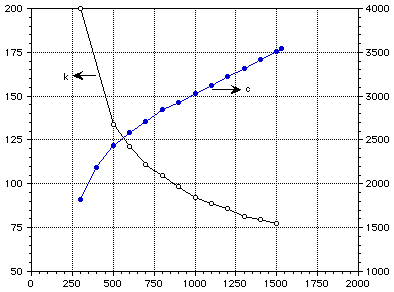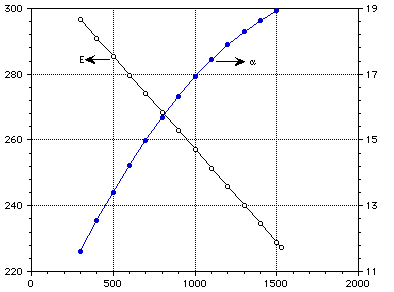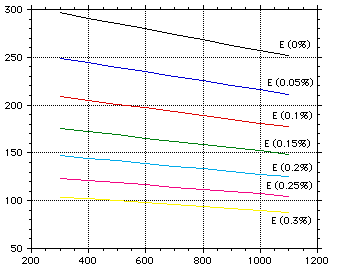 (1)
(1)
Beryllium one of the prime candidate neutron multipliers to enhance tritium generating performance in the blanket. Key features associated with the use of beryllium include its effective high neutron multiplication cross section, high thermal conductivity, low density and low activation properties. Beryllium is also used as a plasma facing material, primarily on the basis of its very low-Z. The major difficulties related to using beryllium are the relativily low melting temperature, high sputtering rate, radiation induced swelling, tritium retention charateristics, chemical toxicity, and exothermic reaction with steam.
GENERAL PROPERTIES - BERYLLIUM [1]
Physical properties
Boiling Point : 2470 C
Density @ 20 C : 1.848 g/cm3
Melting Point : 1278 C
Electrical properties
Electrical Resistivity @ 20 C : 3.3 u [[Omega]] cm
Temperature Coefficient @ 0 - 100 C : 0.0090/K
Superconductivity Critical temperature : 0.026 K
Thermal Properties
Latent Heat of Evaporation : 32470 J/g
Latent Heat of fusion : 1350 J/g
Linear Expansion Coefficient
@ 0 - 100 C : 12.0x10-6 m/m-K
Specific Heat @ 25 C : 1825 J/kg-K
Thermal Conductivity, @ 0 - 100 C : 201 W/m-K
Mechanical properties
Material Conditons Soft Hard Polycrystlline
Bulk Modulus (GPa) 110
Hardness-Vickers 150 200
Poisson's Ratio 0.02
Tensile Strength 310 550
(MPa)
[[sigma]]y (MPa) 240 345
E (GPa) 318
DATA AND CORRELATIONS
Table 1 presents the thermal and structural properties of beryllium as a function of temperature, refs [2, 3, 4, 5, 6]. The following polynomial correlations are representative of the change of thermal and structural properties of beryllium with temperature at zero porosity, p=0:
 (1)
(1)
 (2)
(2)
 (3)
(3)
 (4)
(4)
 (5)
(5)
 (6)
(6)
with T in degrees Kelvin and Eqs 1-5 are valid in the temperature range 300-1500 K. Data for the elastic modulus E, considering the effect of porosity, are from the following expression:

with E in GPa, T in Kelvin and p the volume fraction of pores, ref [4]. The values of E appearing in Table 1 are at zero porosity (p=0). Since porosity for beryllium (and other ceramics) affects the structural properties Table 2 was compiled and shows the effect of porosity on E, with p in the range 0.0-0.3.
Table 1 Thermal and structural properties of beryllium
T K [[rho]] E GPa [[nu]] k W/m-K c J/kg-K [[sigma]] [[alpha]]
kg/m3 y (10-6)
(0.2)MPa m/m-K
300 1850.0 296.605 0.070 200.000 1825 394.741 11.602
373 292.482 170.306 2095 364.860 12.343
400 290.962 161.526 2191 354.078 12.540
473 286.839 142.104 2364 325.657 13.237
500 285.319 133.920 2435 315.415 13.418
573 281.196 123.730 2559 288.454 14.072
600 279.676 121.370 2589 278.752 14.238
673 275.553 112.091 2702 253.251 14.848
700 274.033 110.900 2714 244.089 14.997
773 269.910 104.667 2813 220.048 15.564
800 268.390 104.630 2852 221.426 15.697
900 262.747 98.350 2928 180.763 16.338
973 258.624 95.201 2998 159.642 16.818
1000 257.104 92.070 3026 152.100 16.919
1100 251.461 88.720 3123 125.437 17.441
1200 245.818 85.790 3220 100.774 17.903
1300 240.175 81.610 3316 78.111 18.305
1400 234.532 79.520 3413 57.448 18.648
1500 228.889 77.420 3512 38.785 18.932
Table 2 Effect of porosity on elastic modulus
T K E (0 %) E (0.05 E (0.1 E (0.15 E (0.2 E (0.25 E (0.3
GPa %) GPa %) GPa %) GPa %) GPa %) GPa %) GPa
300 296.61 248.99 209.01 175.46 147.29 123.64 103.79
400 290.96 244.25 205.04 172.12 144.49 121.29 101.82
500 285.32 239.51 201.06 168.78 141.69 118.94 99.84
600 279.68 234.78 197.08 165.44 138.88 116.59 97.87
700 274.03 230.04 193.11 162.11 136.08 114.23 95.89
800 268.39 225.30 189.13 158.77 133.28 111.88 93.92
900 262.75 220.56 185.15 155.43 130.48 109.53 91.95
1000 257.10 215.83 181.18 152.09 127.67 107.18 89.97
1100 251.46 211.09 177.20 148.75 124.87 104.82 88.00
k (W/m-K) c (J/kg-K)

Temperature (K)
Figure 1 : Thermal conductivity and specific heat of beryllium.
E (GPa) [[alpha]] (10-6 m/m-K)

Temperature (K)
Figure 2 : Elastic modulus and coefficient of thermal expansion for beryllium.
[[sigma]]y (MPa)

Temperature (K)
Figure 3 : Yield stress of beryllium.

Temperature (K)
Figure 4 : Effect of porosity on the elastic modulus of beryllium.